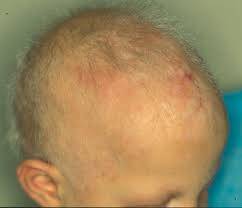Congenital Hypotrichosis
Congenital hypotrichosis is a rare genetic condition characterized by sparse or absent hair growth from birth. It can affect the scalp, body, or both and may occur as an isolated condition or as part of a syndrome.
---
Causes
1. Genetic Mutations:
Mutations in genes responsible for hair follicle development (e.g., HR, LIPH, or DSG4 genes).
These mutations disrupt normal hair follicle structure or function.
2. Inherited Conditions:
Autosomal dominant, autosomal recessive, or X-linked inheritance patterns may be involved.
3. Associated Syndromes:
Ectodermal Dysplasia: Affects hair, skin, nails, and teeth.
Noonan Syndrome: Includes hypotrichosis as part of a broader spectrum of features.
---
Signs and Symptoms
1. Sparse or Absent Hair:
Minimal or no hair on the scalp, eyebrows, eyelashes, or body from birth.
Hair may be thin, fragile, or patchy.
2. Hair Texture:
The hair, if present, may be light-colored, brittle, or prone to breakage.
3. Delayed Hair Growth:
Hair grows slower than normal, or new hair may not replace shed hair.
4. Associated Features (if part of a syndrome):
Abnormal teeth, nails, or skin (e.g., dry or scaly).
Developmental delays or other systemic issues, depending on the syndrome.
---
Effects
1. Cosmetic Concerns:
Social or emotional challenges due to visible hair loss or lack of hair.
2. Sun Sensitivity:
Increased risk of sunburn on exposed areas of the scalp or body.
3. Psychological Impact:
Low self-esteem, anxiety, or social isolation, especially in older children or adults.
4. Potential Medical Issues (if syndromic):
Additional complications related to the underlying genetic syndrome.
---
Solutions
Medical Management
1. Diagnosis:
Genetic testing to identify mutations and confirm the diagnosis.
Skin biopsy (in some cases) to examine hair follicles.
2. Associated Conditions:
If part of a syndrome, manage other symptoms with a multidisciplinary approach (e.g., dentists, dermatologists, and pediatricians).
---
Cosmetic Solutions
1. Wigs or Hairpieces:
High-quality wigs for the scalp and false eyelashes for cosmetic enhancement.
2. Tattooing:
Cosmetic tattooing (microblading) for eyebrows or scalp micropigmentation for a fuller appearance.
3. Camouflaging Products:
Use of hair fibers, sprays, or powders to create an illusion of fuller hair.
---
Hair Growth Stimulation
1. Topical Treatments:
Minoxidil may help stimulate existing hair follicles, though its efficacy varies.
2. Hair Transplants:
Rarely performed and depends on the availability of healthy donor hair follicles.
---
Protective Measures
1. Sun Protection:
Use hats, scarves, or sunscreen to protect the scalp and other exposed areas.
2. Moisturizers:
Keep the scalp hydrated to prevent dryness and irritation.
---
Prevention and Long-Term Care
Genetic Counseling:
For families with a history of congenital hypotrichosis, genetic counseling can help assess the risk of passing it on to offspring.
Regular Monitoring:
Routine follow-ups with dermatologists to manage symptoms and monitor potential complications.
---
When to Seek Medical Attention
If hair loss is accompanied by other physical abnormalities or developmental delays.
For persistent psychological distress related to appearance.
While there is no definitive cure for congenital hypotrichosis, cosmetic and medical interventions can improve quality of life and address associated challenges effectively.


